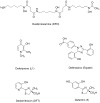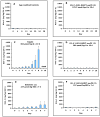Desferrithiocin analogue iron chelators: iron clearing efficiency, tissue distribution, and renal toxicity
- PMID: 21103911
- PMCID: PMC3329216
- DOI: 10.1007/s10534-010-9389-y
Desferrithiocin analogue iron chelators: iron clearing efficiency, tissue distribution, and renal toxicity
Abstract
The current solution to iron-mediated damage in transfusional iron overload disorders is decorporation of excess unmanaged metal, chelation therapy. The clinical development of the tridentate chelator deferitrin (1, Table 1) was halted due to nephrotoxicity. It was then shown by replacing the 4'-(HO) of 1 with a 3,6,9-trioxadecyloxy group, the nephrotoxicity could be ameliorated. Further structure-activity relationship studies have established that the length and the position of the polyether backbone controlled: (1) the ligand's iron clearing efficiency (ICE), (2) chelator tissue distribution, (3) biliary ferrokinetics, and (4) tissue iron reduction. The current investigation compares the ICE and tissue distribution of a series of (S)-4,5-dihydro-2-[2-hydroxy-4-(polyether)phenyl]-4-methyl-4-thiazolecarboxylic acids (Table 1, 3-5) and the (S)-4,5-dihydro-2-[2-hydroxy-3-(polyether)phenyl]-4-methyl-4-thiazolecarboxylic acids (Table 1, 8-10). The three most effective polyether analogues, in terms of performance ratio (PR), defined as mean ICE(primate)/ICE(rodent), are 3 (PR 1.1), 8, (PR 1.5), and 9, now in human trials, (PR 2.2). At the onset of the clinical trial on 9, no data were available for ligand 3 or 8. This is unfortunate, as 3 has many advantages over 9, e.g., the ICE of 3 in rats is 2.5-fold greater than that of 9 and analogue 3 achieves very high levels in the liver, pancreas, and heart, the organs most affected by iron overload. Finally, the impact of 3 on the urinary excretion of kidney injury molecule-1 (Kim-1), an early diagnostic biomarker for monitoring acute kidney toxicity, has been carried out in rats; no evidence of nephrotoxicity was found. Overall, the results suggest that 3 would be a far superior clinical candidate to 9.
Figures






References
-
- Angelucci E, Brittenham GM, McLaren CE, Ripalti M, Baronciani D, Giardini C, Galimberti M, Polchi P, Lucarelli G. Hepatic iron concentration and total body iron stores in thalassemia major. N Engl J Med. 2000;343:327–331. - PubMed
-
- [accessed October 2010];Antech Diagnostics. http://www.antechdiagnostics.com/#.
-
- Babbs CF. Oxygen radicals in ulcerative colitis. Free Radic Biol Med. 1992;13:169–181. - PubMed
-
- Bailly V, Zhang Z, Meier W, Cate R, Sanicola M, Bonventre JV. Shedding of kidney injury molecule-1, a putative adhesion protein involved in renal regeneration. J Biol Chem. 2002;277:39739–39748. - PubMed
-
- Bergeron RJ. Iron: a controlling nutrient in proliferative processes. Trends Biochem Sci. 1986;11:133–136.
Publication types
MeSH terms
Substances
Grants and funding
LinkOut - more resources
Full Text Sources
Other Literature Sources
Medical
Research Materials

